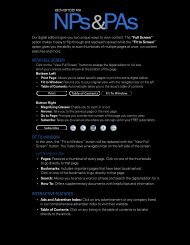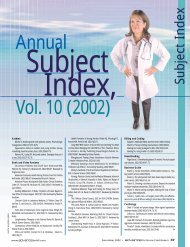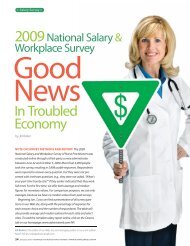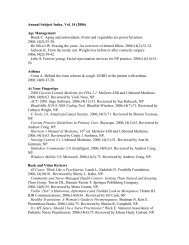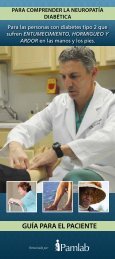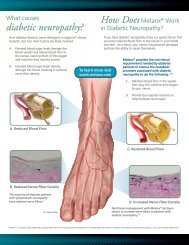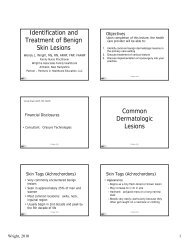View Full Screen - ADVANCE for NPs & PAs
View Full Screen - ADVANCE for NPs & PAs
View Full Screen - ADVANCE for NPs & PAs
Create successful ePaper yourself
Turn your PDF publications into a flip-book with our unique Google optimized e-Paper software.
CME/CE: Neurology<br />
The most effective treatment approach is thorough patient education about<br />
concussion, the patient's particular findings, possible treatments and the<br />
expectation <strong>for</strong> recovery.<br />
Tools are available to assess symptoms<br />
after a concussion. The Rivermead Post-<br />
Concussion Symptom Inventory is a validated<br />
tool that can be used to track the<br />
course of symptoms, including impact<br />
on the patient and his or her daily functioning<br />
(http://www.tbi-impact.org/cde/<br />
mod_templates/12_F_06_Rivermead.pdf). 20<br />
Treatments<br />
The most effective treatment approach<br />
is thorough patient education about concussion,<br />
the patient’s particular findings,<br />
possible treatments and the expectation<br />
<strong>for</strong> recovery. 21 This education should be<br />
repeated at subsequent visits, due to the<br />
short-term memory issues and anxiety<br />
common in this population.<br />
Typical areas to cover in patient education<br />
include the natural history of mTBI<br />
and expected recovery, sleep hygiene techniques,<br />
the need <strong>for</strong> abstinence from drugs<br />
and alcohol (which can increase symptoms<br />
and decrease the brain’s ability to heal),<br />
proper nutrition, coping strategies and<br />
avoidance of repeat concussion. The dangers<br />
of self-medication should be addressed,<br />
since patients may try caffeinated beverages<br />
to treat cognitive issues, alcohol or drugs<br />
to help with sleep and anxiety, and OTC<br />
medications to treat headaches or other<br />
symptoms. Rein<strong>for</strong>ce the need <strong>for</strong> rest and<br />
Table 4<br />
Additional Resources<br />
avoidance of caffeine and alcohol, as well<br />
as use of medications only as prescribed.<br />
Using a medication organizer is one way<br />
of ensuring the patient safely dispenses his<br />
or her own medication in the right dosing<br />
and time frame.<br />
Until the patient has recovered, he or<br />
she should not engage in activities that<br />
will increase symptoms, such as mental<br />
or physical exertion. Depending on home<br />
and work status, specific guidance about<br />
return to work or school may be necessary.<br />
Start with a gradual increase in activity<br />
and increase the amount of activity as<br />
symptoms improve. 11 Driving, climbing<br />
and operating heavy machinery are areas<br />
of concern when visual, balance, cognitive<br />
or coordination difficulties exist.<br />
Cognitive functioning should return<br />
to baseline about 7 days to 1 month after<br />
mTBI. 21 Instruct the patient to follow up<br />
in 1 week if symptoms are not improving.<br />
Make a specialist referral <strong>for</strong> evaluation<br />
of ongoing cognitive symptoms or other<br />
symptoms that are severe, such as depression,<br />
pain or post-traumatic stress. 22,23<br />
These specialists may use neuropsychologic<br />
testing to help determine when return<br />
to work, school or play is appropriate. 24<br />
The involvement of several medical and<br />
complementary specialties may be necessary<br />
to provide complete care. Depending<br />
The Centers <strong>for</strong> Disease Control and Prevention operates a concussion resource<br />
center at http://www.cdc.gov/Concussion/.<br />
The Defense and Veterans Brain Injury Center website, www.DVBIC.org, provides<br />
in<strong>for</strong>mation <strong>for</strong> service members and their families, as well as <strong>for</strong> healthcare providers.<br />
At this site, you can request a copy of the “Mild Traumatic Brain Injury Pocket Guide”<br />
and other tools. These can also be downloaded to iPhones, iPads and devices that use<br />
the Android plat<strong>for</strong>m.<br />
The Veterans Administration and Department of Defense clinical practice guideline <strong>for</strong><br />
the management of mild traumatic brain injury is geared toward healthcare providers<br />
within the VA/DoD healthcare setting, but it can be useful to providers in the civilian<br />
setting. http://www.dvbic.org/pdf/VADoD-CPG---Concussion-mTBI.pdf<br />
The American Association of Neuroscience Nurses and the Association of Rehabilitation Nurses developed<br />
“Care of the Patient with Mild Traumatic Brain Injury.” This document can be downloaded at http://www.<br />
rehabnurse.org/uploads/files/cpgmtbi.pdf<br />
on the provider’s level of com<strong>for</strong>t and the<br />
resources in the clinic, several symptoms<br />
may be appropriate <strong>for</strong> treatment in primary<br />
care. Adopt a “start low and go slow”<br />
approach to any prescription medications.<br />
After injury, the brain is more sensitive<br />
to medication and there<strong>for</strong>e the risk of<br />
side effects increases. 25<br />
Headaches are often managed by primary<br />
care providers, and in this patient<br />
population headache would be a typical<br />
symptom to treat. The cause of post-traumatic<br />
headache is not completely understood,<br />
but the treatments are aimed at the<br />
type of headache that occurs: migrainous,<br />
tension-type, cervicogenic, overuse/<br />
rebound, chronic daily or combination.<br />
Treatments <strong>for</strong> these headaches include<br />
non-narcotic pain medications (avoiding<br />
tramadol because it can increase seizure<br />
risk), nonsteroidal anti-inflammatory<br />
drugs, triptans, tricyclic antidepressants,<br />
anti-epileptic drugs, beta-blockers, botulinum<br />
toxin and occipital blocks. Referral to<br />
a neurologist may be beneficial depending<br />
on the experience of the clinician, the type<br />
of headaches experienced and the response<br />
to attempted treatments. Refer to a dentist<br />
<strong>for</strong> evaluation of pain, popping or clicking<br />
at the temporomandibular joint.<br />
Sleep problems are common in patients<br />
who have experienced a concussion. They<br />
may report trouble getting to sleep, frequent<br />
awakenings, nightmares or weird<br />
dreams. Good sleep hygiene and the<br />
incorporation of relaxation techniques<br />
can be helpful. Trazodone is considered<br />
first-line treatment <strong>for</strong> sleep disturbances<br />
in patients recovering from concussion;<br />
this is an off-label use. 26 The short-term<br />
use of sleep aids such as zolpidem or<br />
eszopiclone can provide quick results<br />
<strong>for</strong> patients. Other possibilities are using<br />
medications that will work on multiple<br />
issues, such as a tricyclic antidepressant<br />
that helps prevent headaches, increases<br />
nighttime sleepiness and may improve<br />
mood. It is important to avoid the use<br />
of benzodiazepines because they may<br />
interfere with neuronal recovery. 27 Referral<br />
18 <strong>ADVANCE</strong> <strong>for</strong> NP & <strong>PAs</strong>



